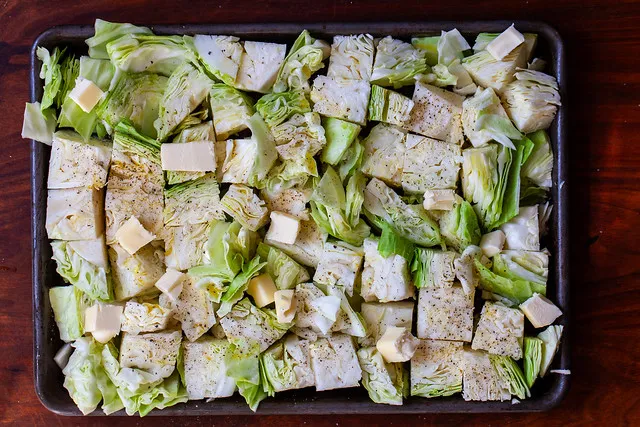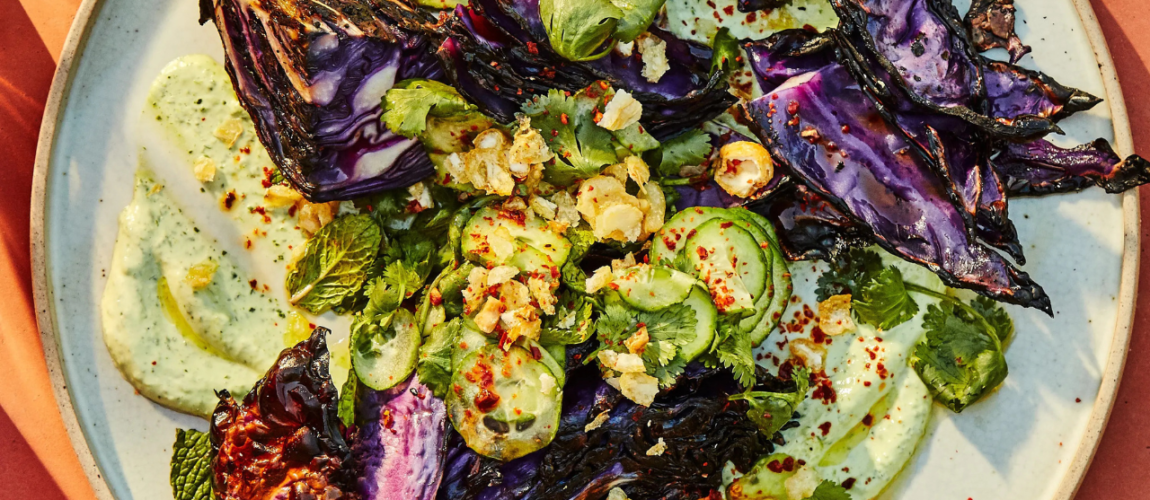The Origins: From Potato Chips to Cabbage Chunks
The story of charred salt and vinegar cabbage begins with an unexpected muse: the salt-and-vinegar potato chip. As Deb Perelman recounts in her third cookbook, Smitten Kitchen Keepers (2022), the recipe was born from an experiment to infuse thick potato slices with the tangy, salty punch of this beloved snack. On a whim, she tossed chunks of green cabbage into the mix, curious to see if the vegetable could absorb the same flavors. The result was nothing short of transformative. “We neglected all of the potatoes to eat the cabbage,” Perelman writes, describing how the cabbage, with its charred edges and vinegar-soaked softness, stole the show.
This serendipitous discovery tapped into a broader culinary trend: the elevation of humble ingredients through bold techniques. Cabbage, often relegated to coleslaw or boiled side dishes, is a recession-era hero—cheap, widely available, and long-lasting. Its sturdy leaves and mild flavor make it a perfect canvas for experimentation, and the salt-and-vinegar treatment draws out its natural sweetness while adding a craveable tang. The recipe’s appeal lies in its accessibility: it requires just a handful of pantry staples (cabbage, olive oil, butter, vinegar, broth, garlic, salt, and pepper) and a hot oven, yet delivers a dish that feels sophisticated and indulgent.
The Recipe: A Masterclass in Simplicity
At its core, charred salt and vinegar cabbage is a roasted vegetable dish that relies on high heat and strategic seasoning to achieve its signature texture and flavor. The recipe, as outlined by Perelman, is straightforward but demands attention to detail. Here’s how it comes together:
Ingredients (Serves 4–6 as a side)
- 2 pounds (905 grams) green cabbage (1 medium head), halved, cored, and cut into 1-to-2-inch chunks
- 3 tablespoons olive oil
- 1 teaspoon kosher salt
- ½ teaspoon freshly ground black pepper
- 2 tablespoons unsalted butter, cut into small pieces
- 6 garlic cloves, peeled
- ½ cup vegetable broth (or water, as a substitute)
- 3 tablespoons white or apple cider vinegar
- Flaky sea salt, for finishing
Method
- Preheat and Prep: Heat your oven to 475°F (245°C). On a rimmed 9-by-13-inch baking sheet, toss the cabbage chunks with olive oil, salt, and pepper, ensuring even coating while keeping the chunks intact. Dot the butter pieces over the top.
- First Roast: Roast for 15 minutes, until the cabbage edges are blackened in spots. The high heat is key—it caramelizes the cabbage’s natural sugars, creating crispy, charred edges.
- Flip and Add Garlic: Using a spatula, gently turn the cabbage chunks over, scattering the garlic cloves across the pan. Roast for another 15 minutes, allowing the cabbage to char further. Perelman notes that it may look “worrisomely charred,” but this is where the magic happens.
- Braise with Broth and Vinegar: Pour the broth and vinegar into the pan, stirring gently to deglaze. Return to the oven for a final 15 minutes, until the garlic is tender and the liquid has reduced to a thin puddle or evaporated entirely.
- Finish and Serve: Sprinkle with flaky sea salt and serve immediately, ideally straight from the pan, as its allure is hard to resist.
The result is a dish that balances textures and flavors with remarkable finesse: crispy, charred edges give way to tender, vinegar-soaked interiors, punctuated by soft, roasted garlic and a salty finish. As Josie Girl Blog raves, “I could eat buckets of cabbage because this recipe is to die for.”
Tips for Success
- Cabbage Choice: Green cabbage is ideal for its sturdiness and affordability. Red cabbage can work but chars faster, requiring closer monitoring.
- Vinegar Variations: White or apple cider vinegar delivers the classic tang, but rice vinegar or sherry vinegar can add nuanced depth.
- Broth Substitute: If vegetable broth isn’t on hand, water works fine, though broth adds a subtle umami boost.
- Convection Caution: If using a convection oven, check for doneness earlier, as the intense heat can accelerate charring.

Why It Works: The Science of Char and Tang
The brilliance of charred salt and vinegar cabbage lies in its interplay of cooking techniques and flavor profiles. Roasting at a high temperature (475°F) triggers the Maillard reaction, where the cabbage’s sugars and amino acids react to create complex, savory flavors and those coveted crispy edges. The charring process also softens the cabbage’s fibrous texture, making it tender yet substantial.
The addition of vinegar and broth introduces a braising element, which tempers the char’s intensity and infuses the cabbage with tangy, acidic notes. Vinegar, a culinary workhorse, cuts through the cabbage’s natural sweetness, while the salt amplifies every flavor, mimicking the addictive quality of potato chips. The garlic cloves, roasted until soft and mellow, add a subtle sweetness that rounds out the dish. As one Reddit user noted, “She wrote that it would be ‘worrisomely charred’ but perfect, and it was.”
This combination of roasting and braising also makes the dish forgiving. Even if the cabbage looks overly charred, the vinegar and broth revive it, ensuring a harmonious balance. The result is a dish that’s both rustic and refined, appealing to novice cooks and seasoned chefs alike.
Cultural Resonance: Cabbage as a Culinary Hero
Cabbage has long been a staple in cuisines worldwide, from German sauerkraut to Korean kimchi, Russian borscht, and Irish colcannon. Its affordability and versatility have made it a lifeline during economic hardship, earning it the moniker “recession-era vegetable dream” among fans. In charred salt and vinegar cabbage, this humble ingredient is reimagined, shedding its dowdy reputation for a starring role.
The dish also taps into broader food trends, such as the rise of vegetable-forward cooking and the embrace of bold, tangy flavors. Restaurants like Sylvain in New Orleans have championed charred cabbage with sophisticated pairings like peanut romesco and sherry vinegar, signaling its potential as a fine-dining contender. Meanwhile, home cooks have embraced its simplicity, with Smitten Kitchen fans sharing stories of converting cabbage skeptics—including children—into ardent fans. One commenter shared, “I had to fight off my 11, 10, and 5-year-old daughters to eat the rest of this!”
The salt-and-vinegar flavor profile, rooted in the nostalgia of potato chips, adds a layer of universal appeal. It’s a taste that transcends cultures, evoking childhood snacking memories while delivering a grown-up sophistication. This duality—nostalgic yet innovative—has helped the dish resonate across diverse audiences.
Versatility: Beyond the Side Dish
While charred salt and vinegar cabbage shines as a side dish, its versatility makes it a culinary chameleon. Here are some ways to incorporate it into your repertoire:
- As a Main Course: For a vegetarian meal, pair it with a protein like crispy tofu or a fried egg, served over rice or quinoa. The dish’s bold flavors can carry a plate.
- With Fruit: Add sliced apples or pears (Granny Smith or Braeburn work well) after the second roast for a sweet-tart contrast, as suggested by a Smitten Kitchen commenter.
- In Tacos or Wraps: Use the charred cabbage as a filling for tacos or flatbreads, topped with yogurt sauce or avocado for creaminess.
- As a Salad Topper: Toss leftovers with greens, nuts, and a vinaigrette for a hearty salad that holds up well.
- With Meat or Fish: Serve alongside pork chops, grilled steak, or seared scallops, as its acidity cuts through rich proteins.
The dish’s adaptability extends to dietary preferences. It’s naturally gluten-free, low-carb, and vegetarian, and can be made vegan by swapping butter for olive oil or ghee. For a paleo version, Gnarly Nutrition suggests sautéing cabbage with onions in ghee, finished with apple cider vinegar and red pepper flakes.
Critical Perspective: Strengths and Limitations
Charred salt and vinegar cabbage is a triumph of simplicity, but it’s not without its challenges. The high roasting temperature requires vigilance to avoid over-charring, especially in convection ovens. Some cooks, like a Reddit user who admitted to under-charring, may struggle to achieve the “worrisomely charred” sweet spot. The dish’s bold flavors—particularly the vinegar—may also polarize diners. As Perelman acknowledges, “I know it’s not for everyone.”
Compared to other cabbage preparations, such as Chinese sautéed cabbage with vinegar sauce or Korean-inspired charred cabbage with gochujang vinaigrette, this recipe leans heavily on Western flavor profiles, which may limit its appeal in global cuisine contexts. Its reliance on green cabbage also means it lacks the visual vibrancy of red or savoy varieties, though this is a minor quibble given its flavor payoff.
On the flip side, the recipe’s accessibility and affordability are major strengths. With a cost of roughly $5–7 for a full batch (depending on cabbage prices), it’s a budget-friendly option that rivals pricier vegetable sides like roasted Brussels sprouts. Its ability to convert cabbage skeptics—evidenced by countless online testimonials—further cements its status as a game-changer.

The Verdict: A Dish Worth Celebrating
Charred salt and vinegar cabbage is a testament to the power of simple ingredients, bold techniques, and a touch of creativity. It takes a vegetable often dismissed as utilitarian and transforms it into a dish that’s craveable, versatile, and deeply satisfying. Whether you’re a seasoned cook or a kitchen novice, this recipe offers a low-risk, high-reward way to explore the magic of charring and the allure of salt and vinegar.
As you preheat your oven and slice your cabbage, prepare for a sensory experience that defies expectations. The first bite—crisp, tangy, and faintly sweet—will likely confirm what Perelman’s fans already know: this is cabbage at its very best. So, embrace the char, savor the tang, and let this humble vegetable steal the show at your next meal.

